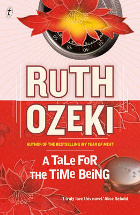A Tale for the Time Being by Ruth Ozeki

Text Publishing, 2013. ISBN 9781922079183.
(Age: Adult and mature secondary readers). Even though Eleanor
Catton's The Luminaries is a very deserving winner of the
2014 Man Booker Prize, my preference from the short list is Ruth
Ozeki's A Tale for the Time Being. The structure is as sophisticated
and revolutionary as that of the winner - and structure is paramount
in both.
Quantum physics is enlisted in A Tale for the Time Being to
reinforce the theme of time and its fluidity. Schrodinger's Cat
makes an appearance and this famous experiment is also explained in
one of the appendices. The title gives another clue as to the
importance of time in this novel and Proust's book, A la
recherche du temps perdu (In Search of Lost Time) plays
an integral part in the plot.
One of two major narrators, Japanese teen Nao, has written a diary
which is found washed up from the ocean by Canadian/Japanese author,
Ruth. There is a commonality between the character and actual
author, Ruth. Nao hasn't coped with her family's ignominious return
to Japan from the United States. He father tries to kill himself,
she is bullied at school, prostitutes herself at the French maid
cafe and is also planning her own suicide. Ruth becomes concerned
about Nao's safety and the story metafictively unites seemingly
impossible, overlapping worlds. Words and pages disappear, time
bends.
The narrative is set soon after the Fukushima nuclear power-station
meltdown, and the earlier tragedy of World War II's reluctant
kamikaze pilots is juxtaposed with this. Japanese content and words
are further explored with helpful footnotes, which also makes this
novel of interest to senior students exploring Asian literature. The
book was written for adult readers so some explicit scenes need a
closer look by individual schools before offering this brilliant,
and ultimately hopeful, novel to students.
Joy Lawn